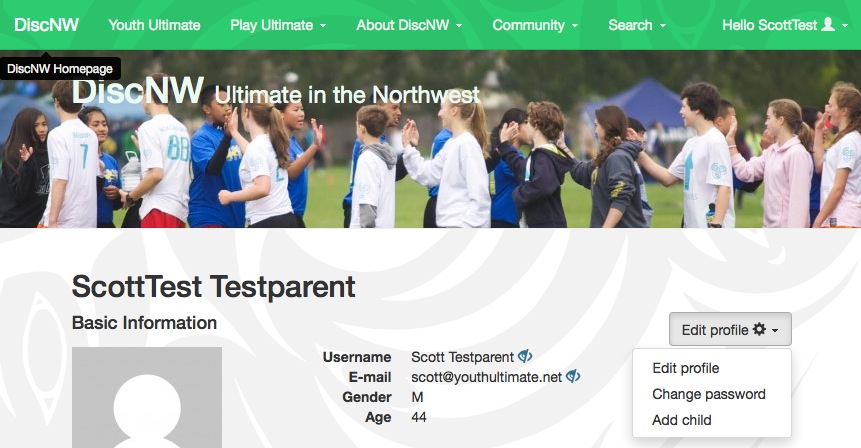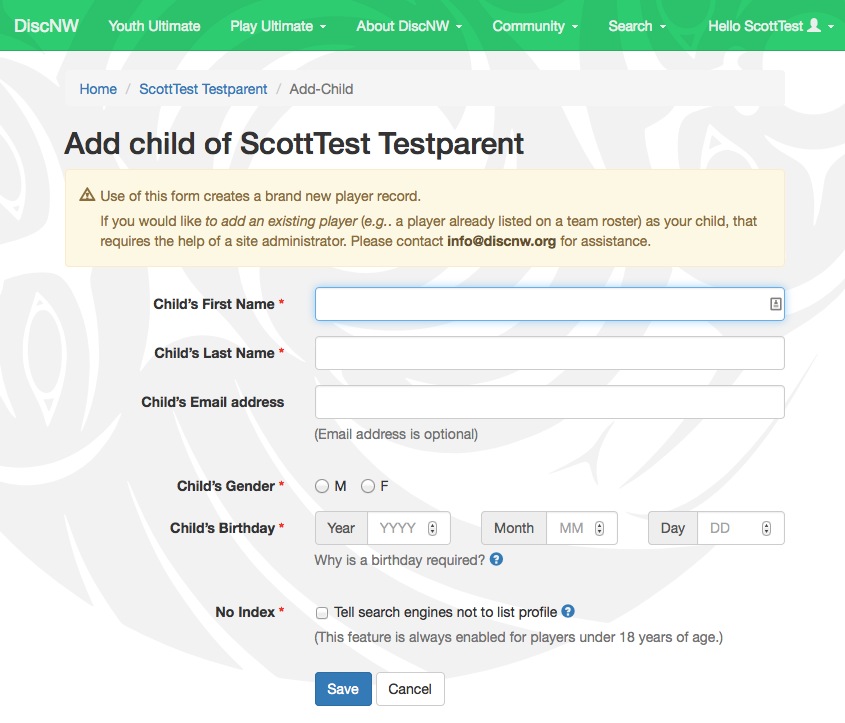William Bartram (aka “Bunny”) had been Executive Director of the Northwest Ultimate Association (aka DiscNW) for almost 10 years when he gave the following presentation at the inaugural 2014 Youth Ultimate Coaching Conference.
Below are the notes I took (along time stamps) while watching the recording archived by the Bay Area Disc Association and Skyd Magazine’s YouTube channel. The first slides offered a little background on Bunny (which is otherwise hard to find):
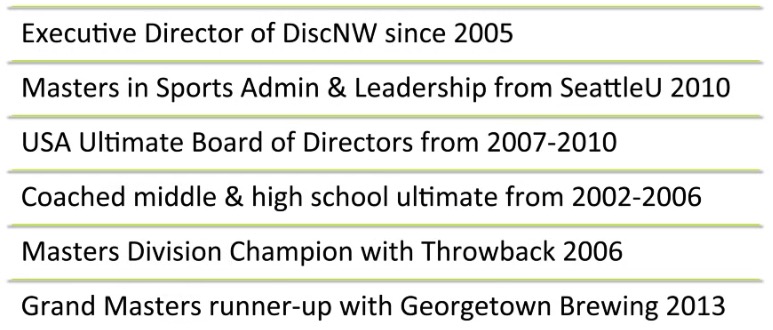
“Perspectives on Youth Ultimate Programming for Coaches”
Overview of youth ultimate in Seattle
- Time line —
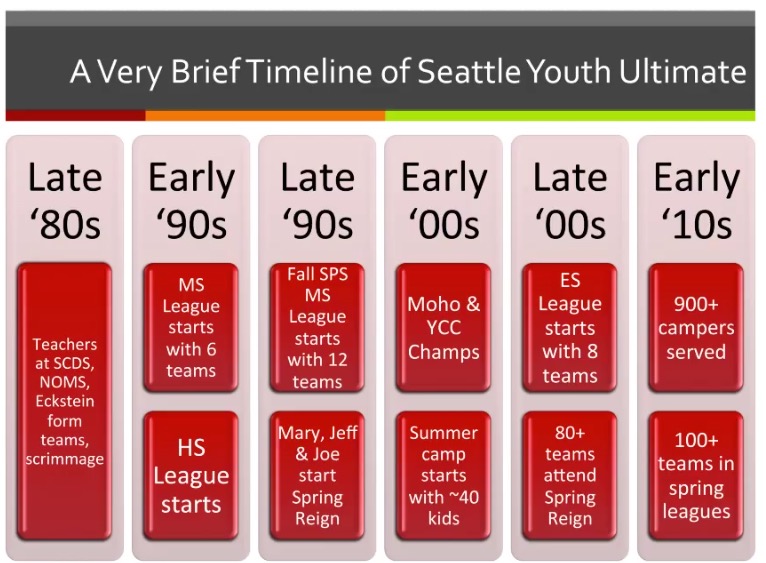
- Early youth scene in Seattle was all coach-driven. Key coaches were teachers who formed teams independently at their schools and eventually organized scrimmages
- Mary Lowry – SCDS
- Dan Costigan
- Joe Bisgianno — Northwest School?
- Mary would photocopy rules & newspaper clippings and send to PE teachers around town
- Over time a league developed (MS in lat 1990s)
- Those middle school players drove development at HS level because they wanted to keep playing
- Jeff Jorgensen, Mary and Joe started Spring Reign [in 1998?]
- Joey Gray and others formed DiscNW (mostly focused on adult players)
- Mike Mullen and Roger Crafts start summer camps (originally in partnership with Seattle Parks with 40 players; 10 years later it would partner with DiscNW serving 900 campers each summer )
- Over time, DiscNW took on administration of youth programs (web site, registration tools, insurance, communication, scheduling, etc.)
- 2004: first full-time staff
- Eventually hired admin assistant
- League thrives due to DiscNW handing logistics so coaches can focus more on coaching
- Financial story
- Originally subsidized by adult leagues
- Now many youth programs are self-supporting
- Youth Development Fund provides financial aid and important programs that might otherwise be unsustainable
- Fall Bid fundraising event
- Hosted youth summits (to get feedback from community)
- (6:10) Overview of DisNW youth programs
- (6:30) Leagues
- Good financial performer
- Spring elementary and middle school
- Fall boys HS; spring girls HS
- Fall middle school league with Seattle Public Schools
- Started when Joey Gray & others lobbied District to use funds from the Families and Education Levy
- SPS pays for fields and coaching stipends
- Principals love it because $ comes from District budget, not their own, and it’s a great after-school program
- DiscNW provides expertise, scheduling, free discs
- Spring club league (but most teams still based on school affiliations)
- Summer league leads towards YCC; 2014 new winter club league also popular with the U16 crowd
- (8:45) Camps
- Very successful as a learning program and financially
- 2013: 255k$ revenue, 150k$ in expenses (100k$ profit supported $16k financial aid & 4k$ for south Seattle free camps [led by Sam Terry])
- Camp directors, counselors, leads all paid
- More popular with MS than HS, but elite HS players getting new elite & leadership training during summer 2014 implemented with Lou Berris (sp? skilled coach)
- (10:33) Tournaments
- Many run but most discontinued because they aren’t profitable & sustainable
- Usually take a lot of energy and serve teams that already have regular playing opportunities
- Trying now to serve teams that have fewer options?
- Spring Reign is largest
- 96 teams (8 elementary, 40 MS, 48 HS)
- Last week of April
- (11:45) Elite Club
- Started with MoHo in late 1990s
- Not affiliated with DiscNW initially
- Started when NOMS MS players wanted to keep playing together as high schoolers
- Interest has waned, but spirit of that program guides current programs
- Elite player development centered on Youth Club Championships
- Early summer club leads into Championships in Minnesota
- League incorporates YCC and other high-level teams
- Hiring committee for coaches who select assistants
- Coaches paid by DiscNW and travel with teams, manages player fees, order uniforms, logistics
- Rusty Brown serves as general manager
- Started with MoHo in late 1990s
- (14:25) Beyond DiscNW (filling gaps, developing new programs)
- Fryz – Started by Randy Lim (over 200 players in 2014; travel to play teams across U.S.)
- RiseUp
- Ultimate for Peace
- All Girl Everything
- Future YUCC focus?
- Up Dawg (UW Element)
- Fall Drizzle (WWU Chaos)
- (6:30) Leagues
(16:20) Conceptual Framework for Events
- Build it and they will come works for a while; but long-term growth requires more planning
- Focus here is on local or regional level (not National like RiseUp)
- Ultimate does not yet enjoy “Varsity Status” —

- Ultimate can grow within a club sport setting with key advanatages:
- Self-officiation, Spirit of the Game
- Strong community
- (22:19) Youth ultimate event components
- Spring Reign as an example with goal being “celebrate community”
- State Championships
- in fall for boys and spring for girls
- (31:30) tried co-ed a couple times, but interest wasn’t there
(32:00) Building a Coaching Community
- “Finding coaches to meet player demand is one of the biggest hurdles to growth in our area.”
- We try to find coaches within our membership
- Low rate of success, but matches are valuable!
- Learning ops for coaches
- Host USAU clinics
- Educate PE teachers
- Development ops
- YCC coaching ops
- Many returning players choose to coach
- Fall 2015 Disc NW starts paying stipends to fall HS boys coaches
- Role of coaches to make organizing easier —
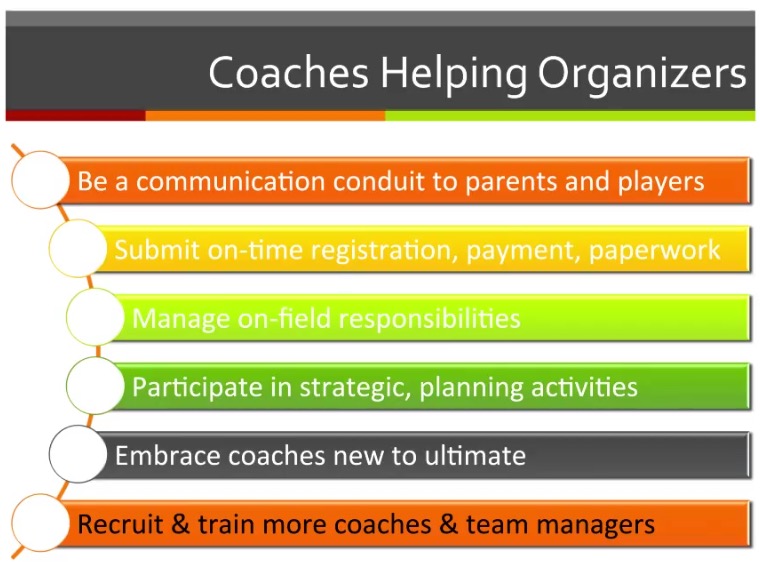
- (40:00) Couple anecdotes about coaches
- Ken Round
- Didn’t know ultimate when he formed MS team and brought to Spring Reign (caused friction)
- Parents brought RVs, set up tents
- Took 6th grade cohort through 12th grade
- Some players went to YCC and Westerns (2nd)
- Fighting in ultimate!
- Seattle team and less experienced Vancouver team
- Fisticuffs in 2nd half
- Spirit circle later in the weekend (including some parents)
- Vancouver team made finals on Sunday playing OR team
- Foul called on final point; resolved without violence; came back to win!
- Help find more coaches! Builds resiliency
- Mr. Jamsheed
- Large program at Bailey Gasherd (sp)
- Terrible at administration (e.g. Spring Reign registration)
- Started team at Jane Addams and recruited team parent to handle logistics
- Mr. Jamsheed
- Ken Round
(45:00) Q&A
- (47:00) How do transition from volunteer to staffed organization?
- (47:25) DiscNW example
- Managing DiscNW was done by operational Board and voluntary E.D.
- Lot’s of uber-volunteers doing things, but buy-in from Board and understanding from the community that there was going to be a paid leader
- 2001: Part-time E.D. Mike Keiran (main job was to figure out how to fund his position!) IT guy, so he made changes to web site and forced payments (via a waitlist).
- As you get organized, you can deliver higher-quality events and therefore raise fees.
- Youth director was hired because Bunny was doing it on his own, but youth was a different customer!
- Hired a part-time organizer and lost money, but promoted youth programs, and hired Wynne and later an assistant to 3.5 FTEs…
- (47:25) DiscNW example


